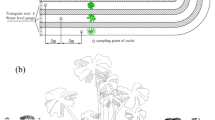Abstract
Effects of rice husk gasification residues (RHGR) application on the fate of herbicides, butachlor and pyrazosulfuron-ethyl, in paddy water were investigated using micro paddy lysimeters (MPLs). The dissipation of both herbicides in paddy water was faster in the RHGR treated MPL than in the control MPL. The average concentrations of butachlor and pyrazosulfuron-ethyl in paddy water in the lysimeter treated with RHGR during 21 days were significantly reduced by 51 % and 48 %, respectively, as compared to those in the lysimeter without RHGR application. The half-lives (DT50) of butachlor in paddy water for control and treatment were 3.1 and 2.3 days respectively, and these values of pyrazosulfuron-ethyl were 3.0 and 2.2 days, respectively. Based on this study, RHGR application in rice paddy environment is an alternative method to reduce the concentration of herbicide in paddy field water and consequently to reduce potential pollution to aquatic environment.

Similar content being viewed by others
References
Boulange J, Watanabe H, Inao K, Iwafune T, Zhang M, Luo Y, Arnold J (2014) Development and validation of a basin scale model PCPF-1@SWAT for simulating fate and transport of rice pesticides. J Hydrol 517:146–156
Chen YL, Chen JS (1979) Degradation and dissipation of herbicide butachlor in paddy fields. J Pestic Sci 4:432–438
Inao K, Kitamura Y (1999) Pesticide paddy field model (PADDY) for predicting pesticide concentrations in water and soil in paddy fields. J Pestic Sci 55:38–46
Iwafune T, Inao K, Horio T, Iwasaki N, Yokoyama A, Nagai T (2010) Behavior of paddy pesticides and major metabolites in the Sakura River, Ibaraki, Japan. J Pestic Sci 35:114–123
Kondo K, Boulange J, Watanabe H (2012) Probabilistic assessment of herbicide runoff from Japanese rice paddies: the effects of local meteorological conditions and site specific water managements. J Pestic Sci 37:312–322
Kookana RS (2010) The role of biochar in modifying the environmental fate, bioavailability, and efficacy of pesticides in soils: a review. Aust J Soil Res 48:627–637
Mesa AC and Spokas KA (2011) Chapter 15: Impacts of biochar (black carbon) additions on the sorption and efficacy of herbicides. In: Kortekamp A (ed) Herbicides and environment. InTech, Rijeka, pp 315–340
Nhung DTT, Phong TK, Watanabe H, Iwafune T, Thuyet DQ (2009) Simulating the dissipation of two herbicides using micro paddy lysimeters. Chemosphere 77:1393–1399
Ok J, Doan NH, Watanabe H, Thuyet DQ, Boulange J (2012) Behavior of butachlor and pyrazosulfuron-ethyl in paddy water in micro paddy lysimeter under different temperature conditions in spring and summer. Bull Environ Contam Toxicol 89:306–311
Pal OR, Vanjara AK (2001) Removal of malathion and butachlor from aqueous solution by clays and organoclays. Sep Purif Technol 24:167–172
Phong TK, Vu SH, Ishihara S, Hiramatsu K, Watanabe H (2011) Exposure risk assessment and evaluation of the best management practice for controlling pesticide runoff from paddy fields. Part 2: model simulation for the herbicide pretilachlor. Pest Manag Sci 67:70–76
Si Y, Wang M, Tian C, Zhou J, Zhou D (2011) Effect of charcoal amendment on adsorption, leaching and degradation of isoproturon in soils. J Contam Hydrol 123:75–81
Spokas KA, Koskinen WC, Baker JM, Reicosky DC (2009) Impacts of woodchip biochar additions on greenhouse gas production and sorption/degradation of two herbicides in a Minnesota soil. Chemosphere 77:574–581
Takagi K and Takanashi S (2003) Development of a technique for reducing herbicide runoff from paddy fields using the PCPF-1 Model and rice husk charcoal powder. In: Proceedings of the third international conference on contaminants in the soil environment in the Australasia-Pacific Region. Beijing, China
Thuyet DQ, Hien TQ, Watanabe H, Saito H, Phong TK, Nishimura T (2010) Micro paddy lysimeter for monitoring solute transport in paddy environment. Paddy Water Environ 8:235–245
Thuyet DQ, Watanabe H, Takagi K, Yamazaki K, Nhung DTT (2012) Behavior of nursery-box-applied imidacloprid in micro paddy lysimeter. J Pestic Sci 37:20–27
Tian C, Wang M, Si Y (2010) Influences of charcoal amendment on adsorption-desorption of iosproturon in soils. Agric Sci China 9:257–265
Vu HS, Ishihara S, Watanabe H (2006) Exposure risk assessment and evaluation of best management practices of pesticide runoff from paddy fields into rivers. Part I, Multi-scale paddy watershed monitoring. Pest Manag Sci 62:1193–1206
Wang HL, Lin KD, Hou ZN, Richardson B, Gan J (2010) Sorption of the herbicide terbuthylazine in two New Zealand forest soils amended with biosolids and biochars. J Soils Sediments 10:283–289
Watanabe H, Nguyen MHT, Souphasay K, Vu SH, Phong TK, Tournebize J, Ishihara S (2007) Effect of water management practice on pesticide behavior in paddy water. Agric Water Manag 88:132–140
Watanabe H, Inao K, Vu SH, Phong TK, Ishihara S, Takagi K, Tournebize J (2008) Chapter 8: Pesticide exposure assessment in rice paddy areas: a Japanese perspective. In: Capri E, Karpouzas D (eds) Pesticide risk assessment in rice paddies. Elsevier, Amsterdam, pp 167–214
Xu J, Li X, Xu Y, Qiu L, Pan C (2008) Biodegradation of pyrazosulfuron-ethyl by three strains of bacteria isolated from contaminated soils. Chemosphere 74:682–687
Ying GG, Williams B (2000) Laboratory study on the interaction between herbicides and sediments in water systems. Environ Pollut 107:399–405
Acknowledgments
This research was partially supported by “Research program for Agricultural Science & Technology Development (Project No. PJ01086501)”, National Academy of Agricultural Science, Rural Development Administration, Republic of Korea.
Author information
Authors and Affiliations
Corresponding author
Rights and permissions
About this article
Cite this article
Ok, J., Pisith, S., Watanabe, H. et al. Effect of Rice Husk Gasification Residue Application on Herbicide Behavior in Micro Paddy Lysimeter. Bull Environ Contam Toxicol 94, 791–795 (2015). https://doi.org/10.1007/s00128-015-1515-7
Received:
Accepted:
Published:
Issue Date:
DOI: https://doi.org/10.1007/s00128-015-1515-7




